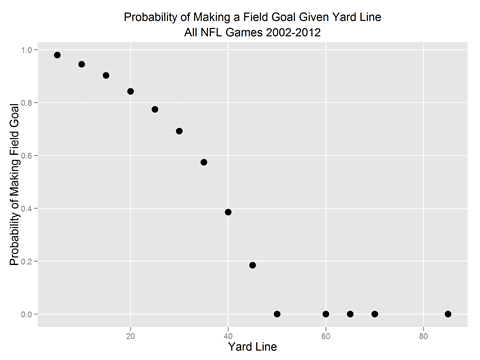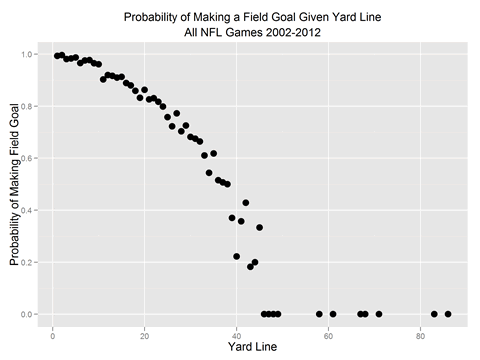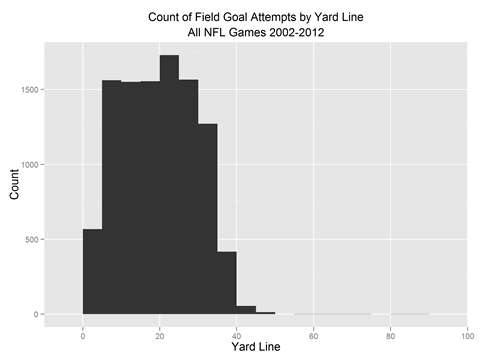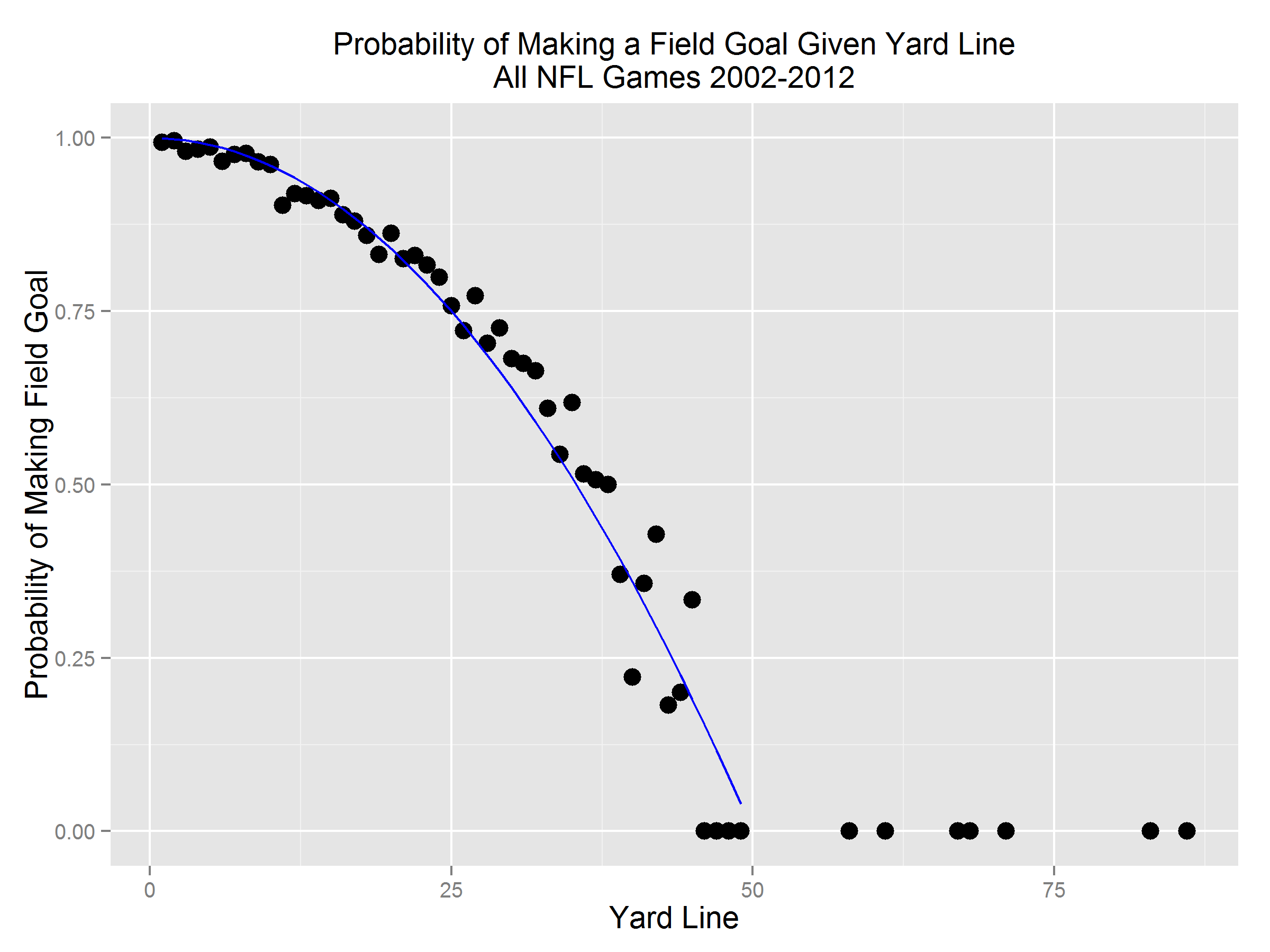Football geeks: your 10,705 field goals are ready
EVERY NFL FIELD GOAL SINCE 2002
ADDENDUM: This Decision Science News post was covered by Bloomberg TV!
We looked at NFL punts before on Decision Science News. That’s old news. Field goals are the new hotness and Super Bowl Sunday is coming up, so let’s look at a kicker’s chances.
We’ve taken the same database and looked at the probability of getting the ball through the uprights depending on the yard line from which the kick starts. The result is above.
O data, you are so beautiful sometimes.
Those in need of a handy formula for the sidelines might want to use the following approximation. Let D be the yard line you are on:
- If D>50, you will miss
- Otherwise, your probability of making a field goal is about 1-.0004*D^2
We tried to fit a logit model, but it wasn’t pretty.
Speaking of beauty, one big data lesson is that data are more beautiful when binned. Here’s the more raw version:
It seems coaches are aware of the maximum distance at which they have a prayer of making a field goal, and don’t even try otherwise:
Graphs were made in R using Hadley Wickham’s ggplot2 package. Pointer to the data can be found at our previous post.
ADDENDUM:
Reader Anders made a chart that looks at the count of good and bad field goals by distance (yard line + 17):
ADDENDUM
We changed the model we had originally posted for one with just 1 free parameter. Here’s the fit:
ADDENDUM
Some folks have asked if some of the longer attempts are noise. It appears so. Here are the descriptions of the attempts from behind the 50 yard line. On a regular attempt, the distance of the field goal is the yard line plus 17, so the case where the yard line is 86 and the field goal distance is suppose to be 68 yards, for example, seems to be a typo.
| ydline | description |
| 58 | (:01) S.Janikowski 76 yard field goal is No Good Center-J.Condo Holder-S.Lechler. A.Cromartie at SD 2 to SD 28 for 26 yards (T.Stewart). |
| 86 | N.Rackers 68 yard field goal is No Good Holder-D.Johnson. R.Droughns at NYG 2 to NYG 31 for 29 yards (T.Castille). |
| 83 | M.Crosby 69 yard field goal is No Good Short Holder-M.Flynn. |
| 86 | R.Bironas 58 yard field goal is No Good Holder-C.Hentrich. P.Buchanon at HST -6 to HST 29 for 35 yards (R.Reynolds). Penalty on HST-C.Anderson Offensive Holding declined. |
| 67 | (:05) W.Richey 51 yard field goal is No Good Center-J.Maese Holder-D.Zastudil. D.Townsend at PIT -5 to BLT 45 for 60 yards. Lateral to J.Farrior to BLT 35 for 10 yards (T.Heap). FUMBLES (T.Heap) RECOVERED by BLT-T.Jones at BLT 42. T.Jones to BLT 42 for no gain (J.Gildon). |
| 61 | (:01) J.Elam 57 yard field goal is No Good Center-M.Lepsis Holder-T.Rouen. C.McAlister at BLT -7 for 107 yards TOUCHDOWN. |
| 71 | (1:46) T.Peterson 48 yard field goal is No Good Center-D.O’Leary Holder-T.Maddox. I.Bashir at IND -9 to IND 37 for 46 yards (R.Bailey). |
| 68 | (:01) J.Hanson 50 yard field goal is No Good Center-B.Banta Holder-J.Jett. D.Sharper at GB -9 to GB 35 for 44 yards (R.Brown). |







Nice work with the data. There have been a few papers written on field goal kicking and the probability of success. Check out Berry and Wood (Chance, 2004) and Bilder and Loughin (Chance, 1998). For both papers, the data collection was actually done by manual examination of the NFL’s play-by-play descriptions for entire seasons. Given the availability of the data now, it would be interesting to see if there are trends over time.
January 28, 2013 @ 10:05 pm
This is a great post. Cool to see that this data is available! I just have two bones to pick:
1) I think some data cleaning may be called for – your longest field goal attempts are too long! I believe the longest attempt ever is widely reported to be a 76-yarder by Sebastian Janikowski in 2008. I took a quick glance at the primary data link and it seems several of the comments report other errors in the data.
2) Typically the holder sets up 6-7 yards behind the line of scrimmage and the distance of the kick is reported from the site of the holder rather than the line of scrimmage. It’s not clear which you are reporting (I’m guessing scrimmage?). Echoing my first point, we know that the longest field goal ever made is 63 yards, and actually this has happened 4 times. There can’t have been that many teams crazy enough to try one that long, so I sort of expected to see a higher percentage than ~0 past 50 yards (especially in the “more raw” data). Do you think the longer reported attempts are just noise?
January 29, 2013 @ 12:37 am
Hi Darren,
I think there is some noise in the file. I’ve made an addendum to the post above.
January 29, 2013 @ 9:18 am
Direction of wind and velocity are more important than distance at long distance.
January 29, 2013 @ 8:04 am
Robert: See http://www.advancednflstats.com/2012/01/temperature-and-field-goals.html
January 29, 2013 @ 9:10 am
Fun! I pulled the same data and made the following plot:
http://i.imgur.com/eT6AN9h.png?1
January 29, 2013 @ 6:23 pm
Anders: nice! I will add it.
January 30, 2013 @ 8:23 am
Two other possibilities for research along these lines:
– Canadian football. The goalposts are at the *front* of the end zone, and the hash marks are further apart (the field is wider). So there is such a thing as an 8-yard field goal in the CFL. For those very short field goals, if the previous play goes dead outside the hash marks, there can be a noticeable angle, since the kicker is no longer right in front of the uprights.
– Rugby. A conversion (point-after-touchdown equivalent) is kicked from level with where the “touchdown” for the try was made (which is a literal touch-down). This could be from right in front of the posts, or way out on the sideline (there are no hash marks in rugby). The kicker can go as far back as they want. Also, rugby kickers use the soccer style, so a kick by a right-footer bends out to the right and back to the left, noticeably (so a right-footed kicker does best from the left side of the field).
Lots of scope there, but I don’t know where there is data.
January 30, 2013 @ 11:25 am
@Ken:
When I was knee high to a tadpole, American football had (2 pole) goalposts at the goal line and hash marks at least as wide as college hash marks today. Then, in which order I don’t recall,
– goal line goal posts mounted on single pole
– goal moved to endzone end line
– hash marks moved inward
It might be instructive, for those sufficiently interested, to examine differences over these changes.
January 31, 2013 @ 12:51 pm
These various flavours of football descended from rugby, which still has two goal posts at the goal line (protected, these days, by large amounts of padding, since the players are not). I think the college and Canadian games are older, so they had closer ties to rugby at their inception, at least. (Rugby doesn’t have hash marks, though rugby union, the 15-man game, has lines parallel to the sidelines but 10 metres in, which have similar effects at bringing play-restarts in from the sidelines that hash marks do.)
January 31, 2013 @ 10:31 pm
I realize this thread is from four years ago. Do you have data or information on the percentage of field goal attempts (1) hitting the goal vertical and horizontal bars, and (2) how many (or what percentage) of those the ball made it through? Thanks
Rene
December 28, 2017 @ 9:25 am
Sorry, I don’t! But I got the data from here … maybe they know http://www.advancednflstats.com/2010/04/play-by-play-data.html
December 28, 2017 @ 11:14 am